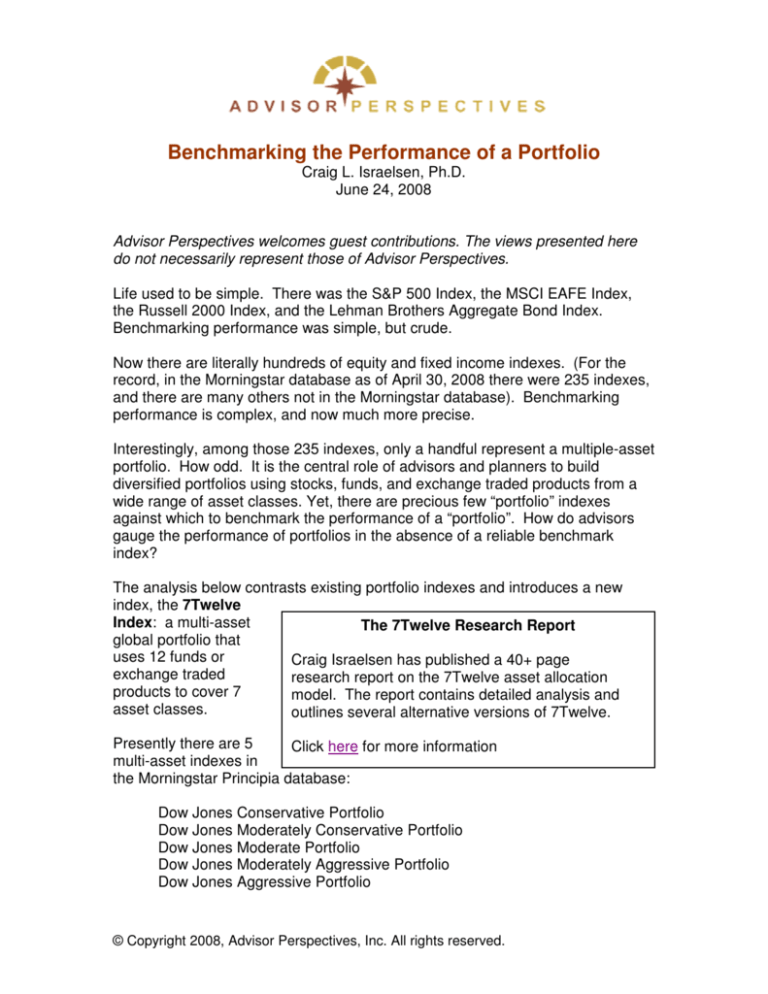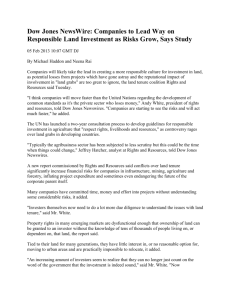
Benchmarking the Performance of a Portfolio
Craig L. Israelsen, Ph.D.
June 24, 2008
Advisor Perspectives welcomes guest contributions. The views presented here
do not necessarily represent those of Advisor Perspectives.
Life used to be simple. There was the S&P 500 Index, the MSCI EAFE Index,
the Russell 2000 Index, and the Lehman Brothers Aggregate Bond Index.
Benchmarking performance was simple, but crude.
Now there are literally hundreds of equity and fixed income indexes. (For the
record, in the Morningstar database as of April 30, 2008 there were 235 indexes,
and there are many others not in the Morningstar database). Benchmarking
performance is complex, and now much more precise.
Interestingly, among those 235 indexes, only a handful represent a multiple-asset
portfolio. How odd. It is the central role of advisors and planners to build
diversified portfolios using stocks, funds, and exchange traded products from a
wide range of asset classes. Yet, there are precious few “portfolio” indexes
against which to benchmark the performance of a “portfolio”. How do advisors
gauge the performance of portfolios in the absence of a reliable benchmark
index?
The analysis below contrasts existing portfolio indexes and introduces a new
index, the 7Twelve
Index: a multi-asset
The 7Twelve Research Report
global portfolio that
uses 12 funds or
Craig Israelsen has published a 40+ page
exchange traded
research report on the 7Twelve asset allocation
products to cover 7
model. The report contains detailed analysis and
asset classes.
outlines several alternative versions of 7Twelve.
Presently there are 5
Click here for more information
multi-asset indexes in
the Morningstar Principia database:
Dow Jones Conservative Portfolio
Dow Jones Moderately Conservative Portfolio
Dow Jones Moderate Portfolio
Dow Jones Moderately Aggressive Portfolio
Dow Jones Aggressive Portfolio
© Copyright 2008, Advisor Perspectives, Inc. All rights reserved.
The composition of each Dow Jones Portfolio is described in the appendix.
The risk and return characteristics of each Dow Jones Portfolio is shown in
Figure 1. Just as theory would suggest, as risk increases (as measured by the
worst 3-year annualized return over the 10-year period from 1998-2007) return
also increases.
Also included in Figure 1 is the 7Twelve portfolio. It seems to defy theory. Its
10-year annualized return of over 11% (from 1998-2007) is associated with a
worst 3-year return of nearly +6%. The S&P 500 Index is also included in Figure
1 as a reference point.
The year-to-year performance of each of the portfolio indexes, as well as the
S&P 500 Index, is shown in Figure 2.
The 7Twelve portfolio is very straightforward. It does not employ exotic tactical
strategies, and was not designed by an optimizer. It simply utilizes 12 broadly
diversified funds in equal weighted allocations (actually 11 funds and one
exchange traded note). At the start of each year, each fund is rebalanced back
to 1/12 of the portfolio value. Tax-efficiency of the portfolio is maximized by
using new cash inflows to accomplish the annual rebalancing. The 7Twelve
portfolio is more diversified than most portfolios, including the Dow Jones
Portfolios.
The 7Twelve portfolio utilizes the following asset classes: large cap US equity,
midcap US equity, small cap US equity, non-US developed equity, non-US
emerging equity, global real estate, natural resources, commodities, aggregate
US bonds, inflation-protected bonds, non-US bonds, and cash.
Figure 1. Risk/Return: 10-Year Period from 1998-2007
© Copyright 2008, Advisor Perspectives, Inc. All rights reserved.
12%
7Twelve
11%
10-Year Annualized Return
10%
9%
DJ Aggressive
DJ Moderately Aggressive
8%
DJ Moderate
7%
DJ Moderately Conservative
DJ Conservative
6%
S&P 500
5%
10%
5%
0%
-5%
-10%
Worst 3-Year Annualized Return
© Copyright 2008, Advisor Perspectives, Inc. All rights reserved.
-15%
-20%
Figure 2. Annual % Returns of Portfolio Indexes
Year
7Twelve
Portfolio
DJ
Conservative
Portfolio
DJ
Moderately
Conservative
Portfolio
DJ Moderate
Portfolio
DJ
Moderately
Aggressive
Portfolio
DJ
Aggressive
Portfolio
S&P 500
Index
1998
0.05
11.30
11.11
10.45
9.63
8.86
28.62
1999
15.50
2.32
10.77
18.00
25.28
32.35
21.07
2000
12.23
5.18
1.23
(2.16)
(5.45)
(8.61)
(9.06)
2001
2.17
3.66
0.53
(2.52)
(5.59)
(8.66)
(12.02)
2002
2.31
8.65
(0.36)
(7.05)
(13.21)
(18.59)
(22.15)
2003
28.61
12.49
20.50
27.18
33.89
41.28
28.50
2004
17.46
6.20
10.69
13.15
15.43
17.98
10.74
2005
12.31
2.64
4.05
7.26
10.05
12.54
4.77
2006
15.13
6.52
8.28
11.91
15.14
18.09
15.64
2007
12.46
6.48
7.47
8.02
8.33
8.66
5.39
10-Year Average
Annualized Return
11.53
6.49
7.26
7.98
8.48
8.95
5.83
Growth of $10,000
$29,782
$18,762
$20,155
$21,558
$22,573
$23,567
$17,624
8.57
3.43
6.37
10.30
14.45
18.64
17.30
0.05
2.32
(0.36)
(7.05)
(13.21)
(18.59)
(22.15)
5.47
3.71
0.46
(3.94)
(8.16)
(12.08)
(14.60)
10-Year Standard
Deviation of Return
Worst One-Year
% Return
Worst Three-Year
Annualized %
Return
The 7Twelve portfolio is a model that can be turned into an investable product
using mutual funds and/or exchange traded funds. For example, the weighted
expense ratio of the 7Twelve portfolio as reported here is 0.69%. This
implementation of the 7Twelve uses a mixture of actively managed funds and
passive exchange traded products; a similar implementation using only passively
managed products (ETFs and ETNs) has an expense ratio of 0.29%.
By comparison, the average annual expense ratio of “world allocation funds” (that
is, funds that invest in a wide variety of global asset classes) is about 1.29%. So,
the annual cost of the 7Twelve portfolio is about half the cost of the average
© Copyright 2008, Advisor Perspectives, Inc. All rights reserved.
global allocation fund. The average expense ratio of all 3,354 funds that had a
full 10 years of performance as of December 31, 2007 was 105 bps, or 1.05%.
For those who seek a higher standard for portfolio performance, the 7Twelve
represents an ideal choice. It has produced stellar returns without subjecting the
portfolio to annual losses over the past 10 years.
© Copyright 2008, Advisor Perspectives, Inc. All rights reserved.
Appendix: (Morningstar descriptions of each Dow Jones Portfolio)
Dow Jones Conservative Portfolio Index: A benchmark designed for asset allocation
strategists who are willing to take 20% of the risk of the global securities market. It is a total
returns index that is a time-varying weighted average of stocks, bonds, and cash The DJConsPI
is the efficient allocation of stocks, bonds, and cash in a portfolio whose semideviation is 20% of
the annualized 36 month historic semideviation of the Dow Jones 100% Aggressive Portfolio
Index (DJAggPI). Stocks are represented by the DJAggPI. Bonds are represented by an equal
weighting of the following four bond indexes with monthly rebalancing: Lehman Government
Bonds Index, Lehman Corporate Bonds Index, Lehman Mortgage-backed Bonds Index, and
Lehman Majors (ex U.S.) Bonds Index. Cash is represented by the 91-Day T-Bill Auction
Average.
Dow Jones Moderately Conservative Portfolio Index: A benchmark designed for asset
allocation strategists who are willing to take 40% of the risk of the global securities market. It is a
total returns index that is a time-varying weighted average of stocks, bonds, and cash The
DJModConsPI is the efficient allocation of stocks, bonds, and cash in a portfolio whose
semideviation is 40% of the annualized 36 month historic semideviation of the Dow Jones
Aggressive Portfolio Index (DJAggPI). Stocks are represented by the DJAggPI. Bonds are
represented by an equal weighting of the following four bond indexes with monthly rebalancing:
Lehman Government Bonds Index, Lehman Corporate Bonds Index, Lehman Mortgage-backed
Bonds Index, and Lehman Majors (ex U.S.) Bonds Index. Cash is represented by the 91-Day TBill Auction Average.
Dow Jones Moderate Portfolio Index: A benchmark designed for asset allocation strategists
who are willing to take 60% of the risk of the global securities market. It is a total returns index
that is a time-varying weighted average of stocks, bonds, and cash The DJModPI is the efficient
allocation of stocks, bonds, and cash in a portfolio whose semideviation is 60% of the annualized
36 month historic semideviation of the Dow Jones Aggressive Portfolio Index (DJAggPI). Stocks
are represented by the DJAggPI. Bonds are represented by an equal weighting of the following
four bond indexes with monthly rebalancing: Lehman Government Bonds Index, Lehman
Corporate Bonds Index, Lehman Mortgage-backed Bonds Index, and Lehman Majors (ex U.S.)
Bonds Index. Cash is represented by the 91-Day T-Bill Auction Average.
Dow Jones Moderately Aggressive Portfolio Index: A benchmark designed for asset allocation
strategists who are willing to take 80% of the risk of the global securities market. It is a total
returns index that is a time-varying weighted average of stocks, bonds, and cash The
DJModAggPI is the efficient allocation of stocks, bonds, and cash in a portfolio whose
semideviation is 80% of the annualized 36 month historic semideviation of the Dow Jones
Aggressive Portfolio Index (DJAggPI). Stocks are represented by the DJAggPI. Bonds are
represented by an equal weighting of the following four bond indexes with monthly rebalancing:
Lehman Government Bonds Index, Lehman Corporate Bonds Index, Lehman Mortgage-backed
Bonds Index, and Lehman Majors (ex U.S.) Bonds Index. Cash is represented by the 91-Day TBill Auction Average.
Dow Jones Aggressive Portfolio Index: A benchmark designed for asset allocation strategists
who are willing to take 100% of the risk of the global securities market. It is a total returns index
formed by equally weighing nine equity style indexes with monthly rebalancing. The nine equity
style Indexes Include: Dow Jones U.S. Large Cap Value, Dow Jones U.S. Large Cap Growth,
Dow Jones U.S. Mid Cap Value, Dow Jones U.S. Small Cap Value, Dow Jones U.S. Mid Cap
Growth, Dow Jones U.S. Small Cap Growth, Dow Jones Emerging Markets LN, Dow Jones
Europe/Canada, and Dow Jones Asia/Pacific. Beginning in 1980 and before 1/1/1992, the Dow
© Copyright 2008, Advisor Perspectives, Inc. All rights reserved.
Jones Aggressive Portfolio Index (DJAggPI) is depicted by an index created for Dow Jones
indexes by the quantitative group. This index contains all nine relevant equity asset classes
equally weighted and rebalanced monthly.
www.advisorperspectives.com
For a free subscription to the Advisor Perspectives newsletter, visit:
http://www.advisorperspectives.com/subscribers/subscribe.php
© Copyright 2008, Advisor Perspectives, Inc. All rights reserved.









